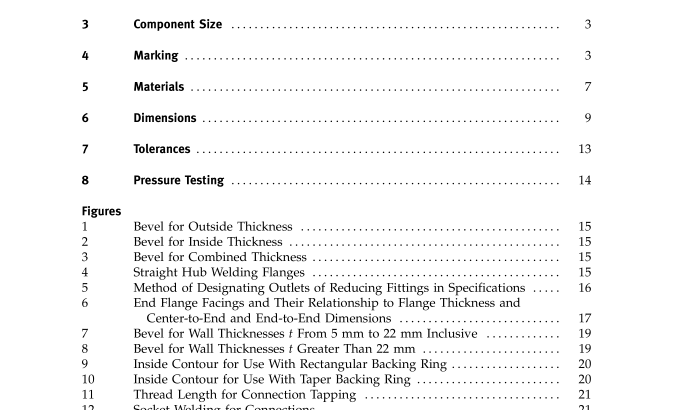ASME B16.5-2013 pdf free download.Pipe Flanges and Flanged Fittings NPS 1/2 Through NPS 24 Metric/Inch Standard
2 PRESSURE–TEMPERATURE RATINGS
2.1 General Pressure–temperature ratings are maximum allow- able working gage pressures in bar units at the tempera- tures in degrees Celsius shown in Tables 2-1.1 through 2-3.19 for the applicable material and class designation. Tables II-2-1.1 through II-2-3.19 of Mandatory Appendix II list pressure–temperature ratings using psi units for pressure at the temperature in degrees Fahrenheit. For intermediate temperatures, linear inter- polation is permitted. Interpolation between class desig- nations is not permitted.
2.2 Flanged Joints A flanged joint is composed of separate and indepen- dent, although interrelated components: the flanges, gasket, and bolting, which are assembled by another influence, the assembler. Proper controls must be exer- cised in the selection and application for all these ele- ments to attain a joint that has acceptable leak tightness. Special techniques, such as controlled bolt tightening, are described in ASME PCC-1.
2.3 Ratings of Flanged Joints
2.3.1 Basis. Pressure–temperature ratings apply to flanged joints that conform to the limitations on bolting in para. 5.3 and on gaskets in para. 5.4, which are made up in accordance with good practice for alignment and assembly (see para. 2.2). Use of these ratings for flanged joints notconforming to these limitations is the responsi- bility of the user.
2.3.2 Mixed Flanged Joints. If the two flanges in a flanged jointdo nothave thesame pressure–temperature rating, the rating of the joint at any temperature is the lower of the two flange ratings at that temperature.
2.4 Rating Temperature The temperature shown for a corresponding pressure ratingis the temperature ofthe pressure-containingshell of the component. In general, this temperature is the same as that of the contained fluid. Use of a pressure rating corresponding to a temperature other than that of the contained fluid is the responsibility of the user, subjectto the requirements ofapplicable codes and regu- lations. For any temperature below −29°C (−20°F), the rating shall be no greater than the rating shown for −29°C (−20°F) (see also paras. 2.5.3 and 5.1.2). 2.5 Temperature Considerations
2.5.1 General. Use of flanged joints at either high or low temperatures shall take into consideration the risk of joint leakage due to forces and moments devel- oped in the connected piping or equipment. Provisions in paras.
2.5.2 and 2.5.3 are included as advisory with the aim of lessening these risks.
2.5.2 High Temperature. Application at tempera- tures in the creep range will result in decreasing bolt loads as relaxation of flanges, bolts, and gaskets takes place. Flanged joints subjected to thermal gradients may likewise be subject to decreasing bolt loads. Decreased bolt loads diminish the capacity of the flanged joint to sustain loads effectively without leakage. At tempera- tures above 200°C (400°F) for Class 150 and above 400°C (750°F) for other class designations, flanged joints may develop leakage problems unless care is taken to avoid imposing severe external loads, severe thermal gradi- ents, or both.
2.5.3 Low Temperature. Some of the materials listed in Tables 1A and 1B, notably some carbon steels, may undergo a decrease in ductility when used at low tem- peratures to such an extent as to be unable to safely resist shock loading, sudden changes of stress, or high stress concentration. Some codes or regulations may require impact testing for applications even where tem- peratures are higher than −29°C (−20°F). When such requirements apply, it is the responsibility of the user to ensure these requirements are communicated to the manufacturer prior to the time of purchase.ASME B16.5 pdf download.ASME B16.5-2013 pdf free download
